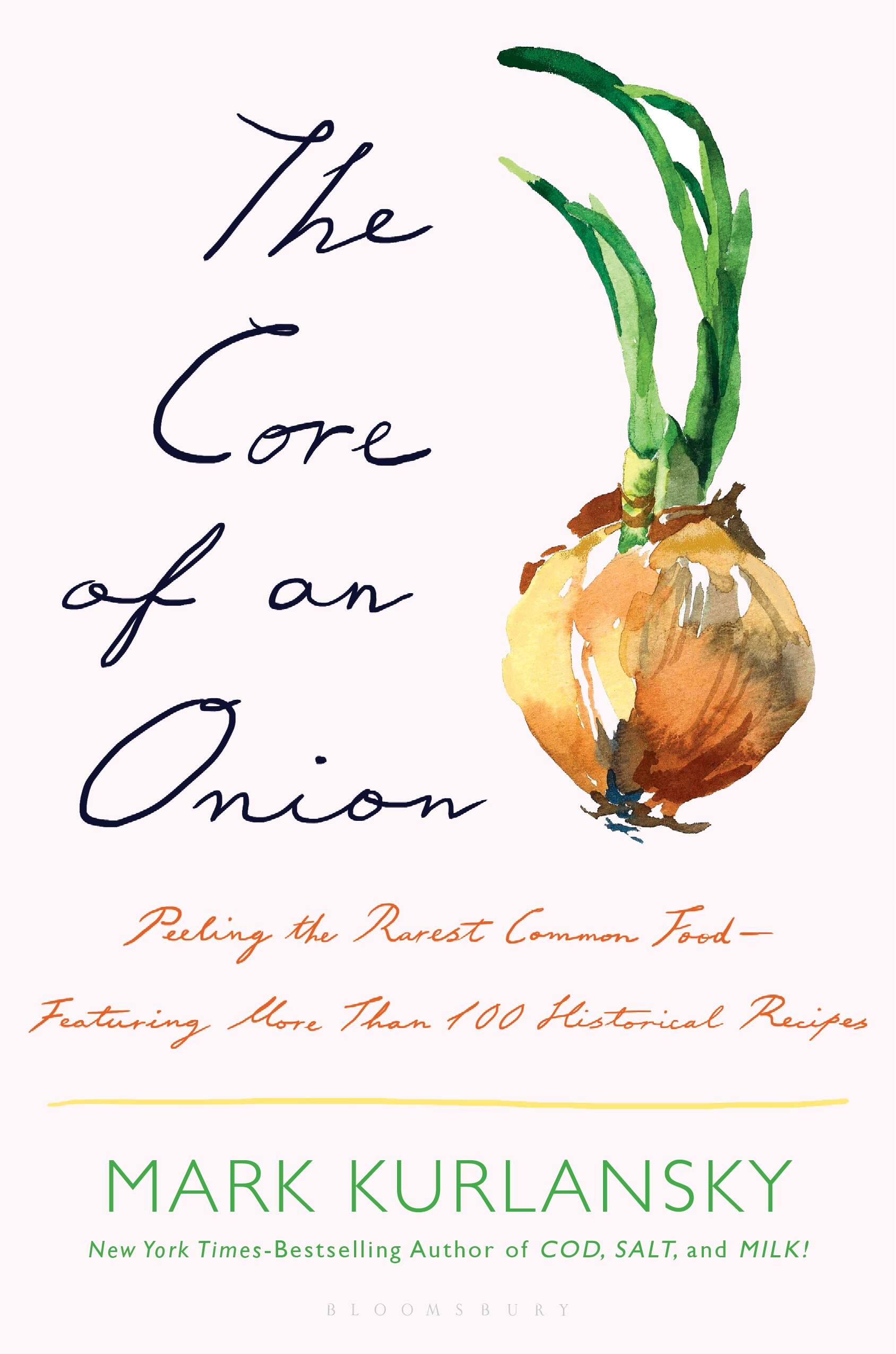Advertisement
In 'The Core of an Onion' Mark Kurlansky peels back the layers of the ubiquitous allium
Resume
Homer’s “Odyssey” calls on onions to give Odysseus power. Olympic athletes used to eat onions to give them strength. Onions have been advertised to cure hair loss. And they’re also claimed to be an aphrodisiac; when Pompeii flooded with lava, charred remains of onions were left behind in brothels.

All these facts about onions come from Mark Kurlansky’s new book “The Core of an Onion.” The book includes the history, interesting facts and recipes including the allium. Kurlansky is also the author of “Cod,” “Salt,” “Milk.” Each book delves into the lush history of each ingredient, expanding out into the culture around them.
Onions are able to grow virtually in every climate and have graced the pages of historical texts for centuries. Even the fact that cutting onions makes most people cry has a fascinating back story.
“What other vegetable is there that fights back? That has a defense mechanism? You want to mess with an onion, you're going to get sulfuric acid spit in your eye,” Kurlansky says. “Onions are designed to defend themselves against mammals, except for humans who are willing to take the pain.”

Book excerpt: 'The Core of an Onion'
By Mark Kurlansky
For thousands of years learned people have argued whether onions were a healthy or unhealthy food. A 600 B.C.E. medical text recommends that religious people such as Brahmins and Hindu widows avoid onions in their quest for deeper spirituality. Onions and garlic, like pork, mushrooms, and a few other foods, were said to be tama, literally containing the quality of darkness. Such tama foods were said to lead to ignorance, sloth, lewdness, and fear in those who ate them. And yet Susruta also writes in the Susruta Sushruta that onions are healthy for digestion, eyesight, joints, and a healthy heart. The manuscript suggested that religious people feed onions to cows and drink the milk and in that way they could enjoy the health benefits of forbidden alliums without ingesting them.
In Chinese Buddhist culture there is a list of five vegetables not to be eaten because of their strong odor. They are all alliums, although sometimes ginger is included. These foods supposedly led to sexual desire and bad temperament. The idea of the five banned strong-smelling vegetables spread in China to Taoism and other religions. But the Chinese, going back to ancient times, have tried to fight fevers, cholera, and dysentery with onion tea.
The ancient Egyptians saw the concentric layers of an onion as a metaphor for the structure of the universe. Onions were painted on the walls of pyramids and tombs, perhaps as a symbol of eternal life, evoked by the sphere within a sphere within a sphere structure of the onion.
Onions were placed in the bodies or by the head of mummies, or tied to the feet or along the legs. Ramses IV, who reigned for only about six years and died in 1150 b.c.e., had onions placed in his eye sockets. Egyptologists argue about the meaning of these funereal onions. Some think the Egyptians believed the strong smell and taste of onions could awaken the dead. But it is also possible that they thought onions would help preserve the mummies.
The circa 1550 B.C.E. Egyptian religious book known as the Ebers Papyrus contains numerous therapeutic uses of onion and garlic. In the second century B.C.E., a formula for a magic spell was recorded that consisted of salt, doe fat, mastic, myrtle, dark bay, barley, crab claws, sage, rose, fruit pits, fig, a dog-faced baboon’s dung, the egg of a young ibis, a single onion, and garlic.
But onions always have a downside. The first-century-C.E. Greek biographer Plutarch wrote that in ancient Egypt, “The priests keep clear of the onion and detest it and are careful to avoid it because it is the only plant that naturally thrives and flourishes in a waning moon. It is suitable for neither fasting nor festival because in the one case it causes thirst and in the other tears for those who partake of it.”
Some Greeks, though, thought onions had positive powers. In Homer’s Odyssey, Odysseus calls on the power of onions to gain him entry to Circe’s lair. A few centuries later, Hippocrates, considered the father of medicine, prescribed onions to prevent pneumonia, as a diuretic, and for healing wounds.
The Olympic athletes of ancient Greece prepared for their contests by eating onions, either for strength and power or for good fortune. An athlete might eat a pound of onions and also drink onion juice, and rub onion on his body. This must have made a strong impression on opponents.
Alexander the Great had his armies eat onions because he thought their strong flavor signaled that they would make his troops strong. Dioscorides, a first-century-C.E. physician who served the military under the Roman emperor Nero, believed in medical uses for onions, garlic, and leeks.
At the same time, Pliny the Elder listed twenty-seven different remedies using onions, sixty-one with garlic, and thirty-nine with leeks. He believed onions could cure bad vision, cure insomnia, heal mouth sores, relieve toothaches, and cure dysentery. “Importance has recently been given to chives by the emperor Nero,” he wrote, “who on certain fixed days of every month always ate chives preserved in oil and nothing else, not even bread, for the sake of his voice.”
***
The most persistent criticism of onions, even more than the sting, is that the chemicals that they release cause bad breath. Ancient Greeks banned onion eaters from the sacred temple of the goddess Cybele because of their breath. Surprisingly, onion breath jokes never got old. The first-century Roman poet Martial wrote:
He who bears chives on his breath
Is safe from being kissed to death.
In Cervantes’s Don Quixote de la Mancha, Don Quixote wisely counsels his peasant vassal, “Eat not garlic nor onions, lest they find out thy boorish origins by the smell.”
A fourteenth-century Arab recipe collection, Kitâb Wasf al-Atima al-Mutada (“The Description of Familiar Foods”), is concerned about the smell of the cook who has been handling onions and recommends, “Wash your hand before ladling, and perfume it against the smell of onions.”
Marion Harland, in an enormously popular cookbook, Common Sense in the Household, published in 1871, said that onion breath could be cured by “chewing and swallowing a few grains of roasted coffee.” It is often suggested that eating parsley cures onion breath, though this has been debunked. Kiwifruit and eggplant have also been proposed. None of these cures has been scientifically proved, however.
There are communities in the United States that still have old ordinances on their books against eating onions in public places, especially movie theaters. Texas A&M University researched and found numerous examples, though they are almost never enforced and most of these communities are not even aware that such ordinances exist. Some are too bizarre to explain. In Ridgeland, South Carolina, a woman weighing more than two hundred pounds cannot be seen eating onions in a restaurant or at a public picnic if she is wearing shorts. It is illegal to eat onions while walking down the street in Northfield, Connecticut. In Dyersburg, Tennessee, it is illegal to enter a movie theater within four hours of having eaten an onion. In Nacogdoches, Texas, there is an ordinance against “young women” eating raw onions, on burgers or otherwise, after six p.m. These forgotten ordinances do suggest that eating raw onions, which they indicate is especially inappropriate for women, was more popular than may be supposed. Otherwise, why have the ordinance?
In fact, the habit of eating raw onions, though often disparaged because of the odor, has been popular in different cultures throughout history. In the year 972, a Muslim merchant visiting the island of Sicily, then part of the Arab Empire, was struck by the quantity of onions in the city of Palermo and appalled by the local habit of eating them raw. He wrote in 974 of Sicilians:
They eat it at home, morning and evening, among all their classes so it spoiled their imagination and damaged their brains and confused their senses and changed their minds and lessened their understanding and discolored their faces.
In many societies, including in seventeenth-century England, eating onions raw came to be thought of as a lower-class taste associated with peasants. Peasants smelled oniony. Jean Baptiste Bruyerin, a sixteenth-century doctor from Lyon, wrote that onions “are eaten raw by rather refined people, the more polished nonetheless prefer them cooked more, first of all because they are healthier that way and also because they do not give off such a strong odor.” John Evelyn, in his 1699 Acetaria: A Discourse of Sallets (salads), allowed that raw onions were “more proper for our Northern Rustics.” The sixteenth-century English derided the Scots for smelling of raw onions: “They nauseate the very aire with their tainted breath, so perfumed with onions, that to an Englishman it is almost infectious,” reported an English traveler in Scotland.
Taking a train through what was then Yugoslavia in the 1970s, I often saw people snacking on onions like fruit. It is common in the Balkans, Romania, and many other parts of the region. I asked a Polish friend if people ate onions like that in Poland. “Oh no,” he sneered. “The Russians and the Ukrainians, but not the Polish.” Then he thought for a moment and added, “Except for my crazy cousin. I will be cooking something and have the food laid out in the kitchen. When it is time for the onion, it is gone. Then I see my cousin over in the corner, munching away. He is crazy.”
The late James Beard, one of the greatest American food writers, not only loved onions; from an early age he loved them raw too. “I crawled into the vegetable bin, settled on a giant onion and ate it, skin and all. It must have marked me for life for I have never ceased to love the hearty flavor of onions.”
From "The Core of an Onion: Peeling the Rarest Common Food – Featuring More Than 100 Historical Recipes" by Mark Kurlansky, on sale Nov. 7 from Bloomsbury Publishing. Copyright © Mark Kurlansky, 2023. All rights reserved.
Emiko Tamagawa produced and edited this interview for broadcast with Todd Mundt. Grace Griffin adapted it for the web.
This segment aired on November 9, 2023.

